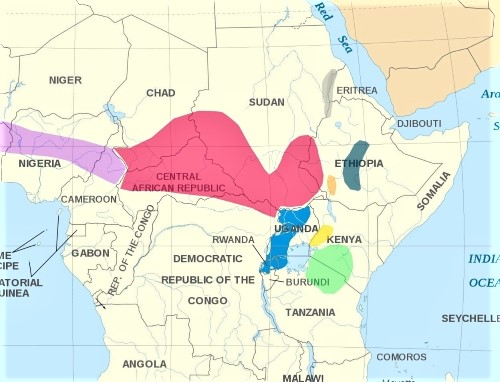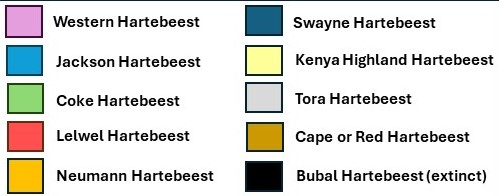 |
 |
Alcelaphus swaynei
Named for English explorer and hunter Col. H. G. C. Swayne.
DESCRIPTION Shoulder height about 47 inches (119 cm).
The Swayne hartebeest is sometimes confused with the tora hartebeest, but should not be, as its coloration is very different and its distribution range well separated.
The Swayne is somewhat smaller than the tora, but has a similar shorter head and lower frontal pedicel. It appears black at a distance, but is actually a deep chocolate brown above, finely speckled with white due to the white tips of the hairs. The shoulders and lower half of tail are black. The hips and legs are lighter than the upperparts. The face is black except for a chocolate band below the eyes. Shoulders, upper legs and lower half of tail are black. The horns (both sexes) are bracket-shaped and slender, growing outward from the pedicel, then upward and backward. They are similar to those of the tora hartebeest, but slightly shorter and very slightly heavier.
DISTRIBUTION Once common throughout the Rift Valley in Ethiopia, and eastward to northwestern Somalia, where it was extremely numerous, but exterminated in most areas before 1930. Now reduced to about 200 individuals in several isolated populations in the southern Rift Valley in Ethiopia.
TAXONOMIC NOTES Includes swaynei (northern Somalia) and noacki (south of Lake Zwai), with swaynei Sclater, 1892 having priority.
Currently, both the Swayne and tora hartebeests are now separate species from the common hartebeest; however, at one time swaynei was regarded as a subspecies of tora, which itself was considered a full species. This resulted in some writers confusing the two, and one should be aware that much published reference material on these animals is misleading or erroneous.
STATUS Listed as endangered by the USF&WS (1979) and the IUCN.
|





